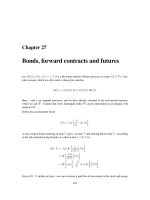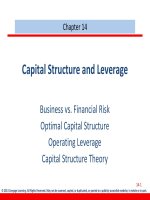Corporate finance chapter 014 forward and futures prices
Bạn đang xem bản rút gọn của tài liệu. Xem và tải ngay bản đầy đủ của tài liệu tại đây (171.67 KB, 15 trang )
Chapter 14: Forward &
Futures Prices
Objective
1
•How to price forward and futures
•Storage of commodities
•Cost of carry
•Understanding financial
Copyright © Prentice Hall Inc. 2000. Author: Nick Bagley, bdellaSoft, Inc.
futures
Chapter 14: Contents
1 Distinction Between Forward &
Futures Contracts
2 The Economic Function of Futures
Markets
3 The Role of Speculators
4 Relationship Between Commodity
Spot & Futures Prices
5 Extracting Information from
Commodity Futures Prices
6 Spot-Futures Price Parity for Gold
7 Financial Futures
2
8 The “Implied” Risk-Free Rate
9 The Forward Price is not a Forecast
of the Spot Price
10 Forward-Spot Parity with Cash
Payouts
11 “Implied” Dividends
12 The Foreign Exchange Parity
Relation
13 The Role of Expectations in
Determining Exchange Rates
Terms
– Open, High, Low, Settle, Change, Lifetime
high, Lifetime low, Open interest
– Mark-to-market
– Margin requirement
– Margin call
3
Characteristics of Futures
• Futures are:
– standard contracts
– immune from the credit worthiness of buyer
and seller because
• exchange stands between traders
• contracts marked to market daily
• margin requirements
4
Spot-Futures Price Parity for
Gold
• There are two ways to invest in gold
• buy an ounce of gold at S0, store it for a year
at a storage cost of $h/$S0, and sell it for S1
• invest S0 in a 1-year T-bill with return rf, and
purchase a 1-ounce of gold forward, F, for
delivery in 1-year
S1 − S 0
S1 − F
− h = rAu = rAu ( syn ) =
+ rf ⇒ F = (1 + rf + h ) S 0
S0
S0
5
Spot-Futures Price Parity for
Gold
(
)
T
• A contract with life T: F = 1 + r f + h S 0
• This is not a causal relationship, but the
forward and current spot jointly
determine the market
• If we know one, then the rule of one
market determines that we know the
other
6
Rule of One Price: No
Arbitrage Profits
Purchase Actual
Au
Sell
T-Bill
Sell
Actual Au
Settle
T-Bill
Sell
Au Forward
Settle
Au Forward
•Au
•Au==Gold
Gold
7
Implied Cost of Carry
• As a consequence of the forward-spot
price parity relationship, you can’t extract
information about the expected future
spot price of gold (unlike one wheat
case) from futures prices
• The implied cost of carry (per $spot) is
h = (F - S0)/S0 - r
f
8
Financial Futures
• With no storage cost, the relationship
between the forward and the spot is
F
S=
T
(1 + rf )
• Any deviation from this will result in an
arbitrage opportunity
9
14.8 The “Implied” Risk-Free
Rate
• Rearranging the formula, the implied
interest rate on a forward given the spot
is
1
T
F
F − S0
r = − 1; if T = 1, r =
S0
S0
• This is reminiscent of the formula for the
interest rate on a discount bond
10
14.9 The Forward Price is not
a Forecast of the Spot Price
• Following the diagrams in Chapter 12 we
might suppose that the expected price of
a stock is σ S2
µ s = S0e
rf + t
2
t
≠ S0e
rf t
=F
• If this is indeed correct, then the forward
price is not an indicator of the expected
spot price at the maturity of the forward
11
Forward-Spot Parity with
Cash Payouts
• The S0 - F relationship becomes
D+F
S0 =
⇒ F = S + rS − D
1+ r
• Note: (forward price > the spot price) if
(D < r S)
• Because D is not known with certainty,
this is a quasi-arbitrage situation
12
14.11 “Implied” Dividends
• From the last slide, we may obtain the
implied dividend
D = (1 + r ) S − F
13
Exchange Rate Example
Time
Japan
15000 ¥
(Borrowed)
U.K.
•150 ¥/£
3% ¥/¥ (direct)
3% ¥/£/£/¥
15450 ¥
15450 ¥
(Repaid)
£100
(Invested)
9%£/£
Forward ¥/£
£109
(Matures)
The Foreign Exchange Parity
Relation
• We used the diagram to show that
$ denominated Forward on Yen $ Denominated Spot for Yen
=
t
(1 + r$ )
(1 + rY ) t
• Recall there is a time structure of
interest, and the appropriate risk free
rate should be used
15









